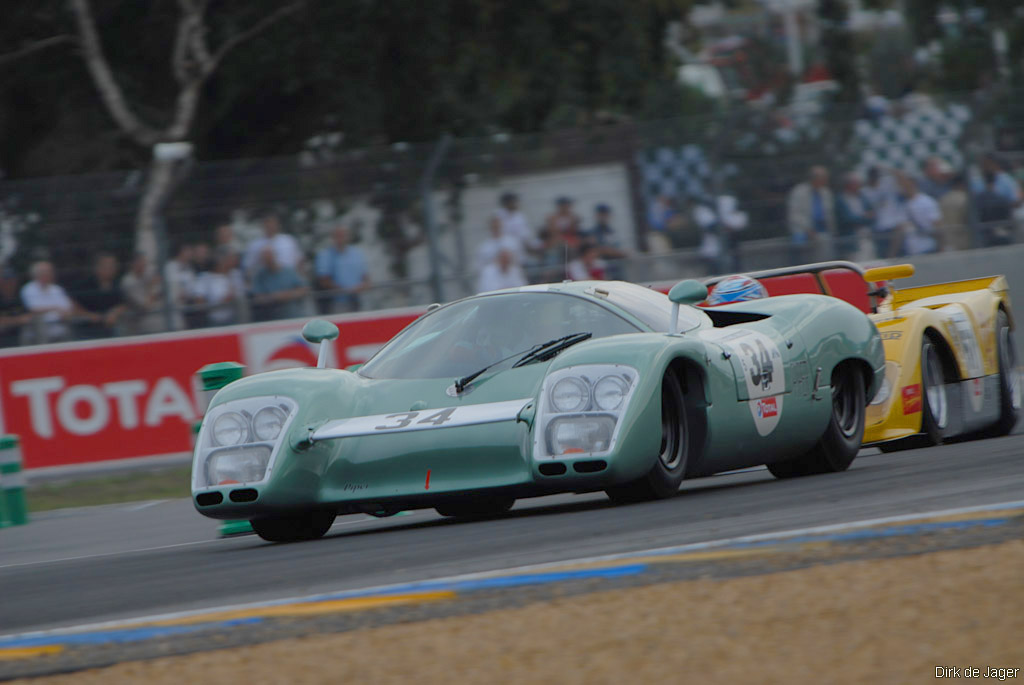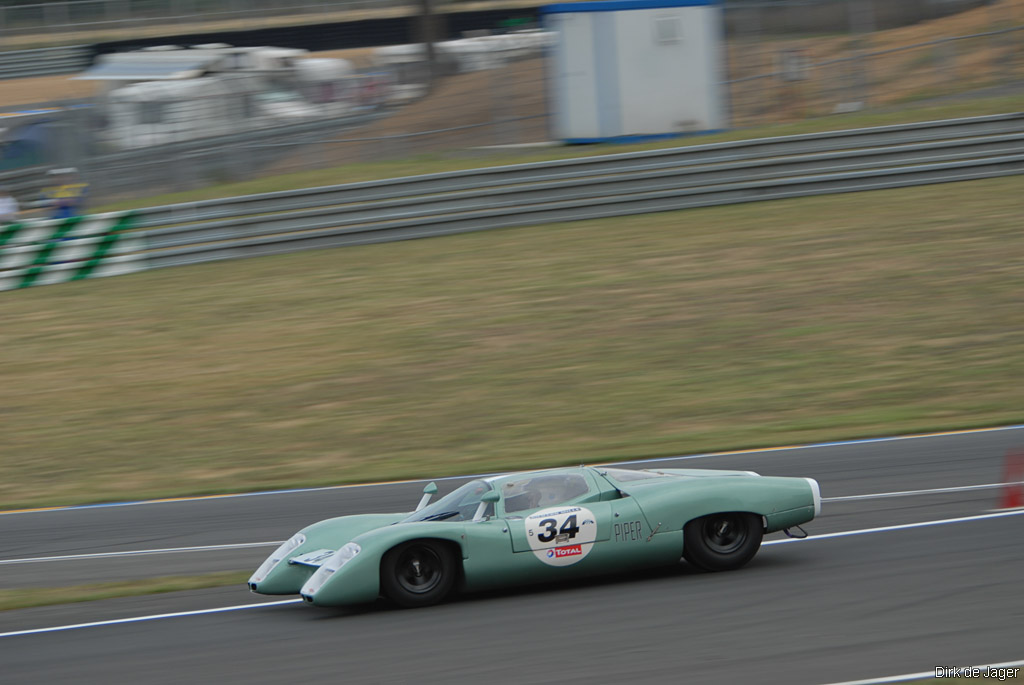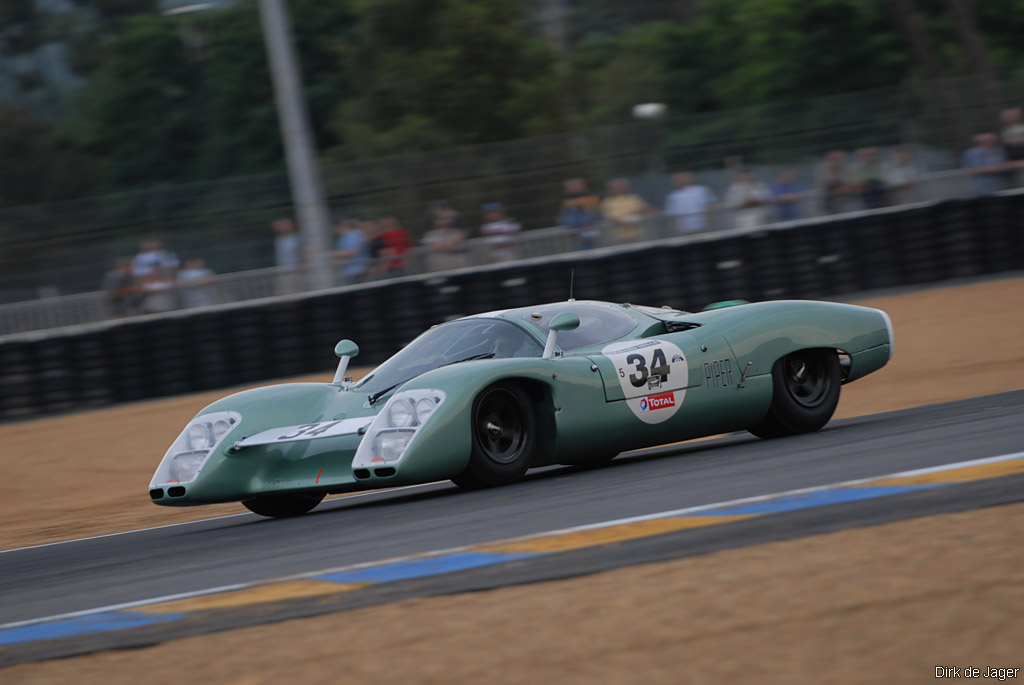1969 Piper GTR
The GTR was a bespoke racecar prepared for the 1969 Le Mans 24 Hours but didn’t race due to a technicality in the regulations. The extremely low car was completely untested before arriving at Le Mans and a multitude of problems ensured it didn’t race.
At the core of the GTR was a fibreglass tub and a 1.3-liter engine from Lotus. Tony Hilder was responsible for the design which only weighed 600 kg. Aerodynamics were a huge part of the design which included a areofoil that was tested at the Kingston Polytechnic.
Unfortunately, the car suffered from multiple problems at Le Mans including the rear hatch coming off down the Mulsanne straight. Once the stewards banned the car from racing it was given to driver Tim Lalonde as reimbursement.
At their 2010 Autosport Auction featuring Grand Prix, Competition, Touring and Rally Cars, Coys offered two Piper cars. This one is described below:
the Piper Car Company evolved from the famous Piper Tuning concern, established by George Henrotte and Bob Gayler in 1966. George had been a successful Formula 3 500 driver, eventually running the successful Gemini team, while Bob’s background had been in development with Weslake and Baldyne Engineering. Whilst developing a range of tuning parts and accessories for Ford engines, the pair offered race preparation services from their Kent premises. Enter Tony Hilder – an artist and freelance designer who had been talent-spotted by Bruce McLaren. The great driver turned team owner took Hilder on to help design McLaren’s M1A sports racer. Hilder’s further experience on projects with companies such as Specialised Mouldings and Lola prompted George Henrotte – on a chance meeting – to offer the young designer a position with the emerging Piper concern.
That chance meeting was to fast-track Piper into the design of a GT car – a tall order for such a small company in its formative years. But the company was bursting with new ideas and enthusiasm – and appeared unafraid of taking on huge development projects. Thus, in 1967, Piper exhibited its prototype GT car – alongside an innovative new F3 car, built from a folded sheet of Mallite. Customer interest was running high for the new GT car and one of those interested parties was to take a instrumental role in the future of Piper Cars. This was Brian Sherwood – a proven Clubmans formula racer who already owned an earlier Piper racer. As Sherwood began to get more involved with Piper, a seminal decision was taken by Henrotte to split the company into two independent concerns so that he and Gaylor could continue developing the extremely successful tuning accessory concern, while Sherwood took over responsibility for all Piper car production, moving the entire car operation to his workshop premises in Wokingham.
Work and sales continued at an unabated pace for the new Piper Cars concern, but frustration was already setting in as Sherwood realised that the development of the existing GT sports racer has reached a plateau. It was time to move on with a new concept – expressly conceived to contest the famous Le Mans 24 Hours event. This new project – designated the ‘GTR’ was to be penned by Hilder, who set about on a closed cockpit, rear engine layout, based around a central monocoque. This advanced concept included rear-mounted water and oil radiators and featured a double-vortex trim on the tail section, designed to divert the cooling air over the radiator to exit under the car – thus not being disturbed by the airflow over the bodywork. A then unique double-nose profile incorporated a revolutionary adjustable aerofoil, designed to help trim the balance of the car at high speed. Further innovative design techniques came in the manufacture of the chassis/body tub, which was constructed in end-grain balsa reinforced with polyester as a core in the floor and bulkheads, laminated between the inner and outer walls of the glass fibre shell with a polyurethane foam filling that produced an immensely strong integral safety cell. Multi-tube front and rear sub-frames carried the suspension and powerplants, which were intended to take all Ford’s twin-cams, BMW’s 2-litre and the Martin and BRM options. The finished car stood barely 30 ins off the ground and was immensely light.
As with all the small manufacturers of this era, many well-reasoned ideals were often found to be much harder to put into practise. Sherwood’s original aim of taking two cars to Le Mans turned out to be a compromise. Just one car – the 1300cc twin-cam GTR on offer today – made it with the 2-litre version staying in the U.K. To say that the team of Sherwood and his Team Concorde drivers, John Burton and Tim Lalonde, were underprepared for the enormity of the task is perhaps an understatement in the full British sense. What accompanied them to La Sarthe were copious amounts of enthusiasm tinged perhaps with a hint of nervous anticipation as the GTR was wholly untested.
Lalonde however had prior experience of Le Mans, having been with the Mini Marcos team at the event in 1967. It was Lalonde who took the untried Piper GTR out in practice, clocking up an incredible 164 mph between in-laps to replenish water. But circumstances were to curtail such promise. The team had set off for Le Mans without getting the 1300cc twin-cam power-plant stamped as such by the RAC. The French demanded that the cylinder head was removed to check the capacity during scrutineering. Such set-back added to a host of infuriating niggles that go with the territory of racing an unproved car. The French racing fraternity certainly didn’t need to witness the potential success of a car that could beat ‘their’ Alpines by a minute on a standing lap and so finally, the Piper GTR was excluded from taking the start of the race due to Lalonde being the only driver to take official practice. Or that’s how the conspiracy story goes. Would it have lasted the race? Probably not – but the interest caused by the car’s presence was extraordinary.
Hollywood legend Steve McQueen came over to check the innovative Piper out, Le Mans personalities Raymond Baxter and Jabby Crombie both declared sympathy and support for the disappointed team. So back to Blighty they went. Lalonde, who owned the Le Mans GTR in lieu of another Piper crashed by the team mechanic during testing at Castle Combe was flat broke and so sold it. Soon after it turned up in the USA and for over a decade was raced extensively before being retired in the late 1990s. The vendor acquired this car some six years ago – re-commissioning the wholly original (apart from a colour change) Le Mans Piper GTR for racing. All sub-frames were taken off the tub and rebuilt.
Most importantly, the attachments to the tub were reinforced. The GRP and Balsa wood monocoque was thoroughly checked but found to be completely sound – a testament to Hilder’s design genius. A full repaint, accurately matching the original colour found on the tub was carried out and original design graphics were studiously duplicated and applied. A permanently powered fan was reinstalled to prevent any overheating of the rear radiators. A full crack testing process was applied to all the suspension components (including 2 sets original magnesium wheels) and such certificates authenticating this process are with the car. Power was upgraded with the fitting of a 1600cc twin-cam engine. (The original 1300cc twin-cam engine is with the car and is complete with new pistons but requires full assembly).
Since this exacting restoration programme was carried out, the refreshed Piper GTR was debuted at the 2005 Goodwood Festival of Speed followed by an invitation to the Silverstone Classic in the following year. More auspiciously, this original car returned to La Sarthe to contest the 2006 Le Mans Classic, where it was reunited with its original driver, Tim Lalonde, some 37 years after the Piper GTR’s first appearance at Le Mans. The restored car was much quicker than Lelonde thought it would be – and this time it not only started but finished the job that it had originally set out to all those years ago. Its latest outing was in a World Sports Racing Masters event at Donington 2008, beating a Ford GT40 to take a well deserved class win. A return invitation for the 2010 Le Mans Classic has been received for this car to once again return to La Sarthe – indicating that the French attitude towards this incredible car has turned from one of deep suspicion to that of great respect.
Story by Supercars.net, Coys
In Detail
| type | Racing Car |
| built at | England |
| engineers | Tony Hilder |
| engine | Lotus-Ford Inline-4 |
| valvetrain | DOHC, 4 Valves per Cyl |
| fuel feed | 2 Weber Carburetors |
| displacement | 1300 cc / 79.33 in³ |
| bore | 83.5 mm / 3.3 in |
| stroke | 59.3 mm / 2.3 in |
| power | 115.6 kw / 155 bhp |
| specific output | 119.23 bhp per litre |
| bhp/weight | 258.33 bhp per tonne |
| body / frame | Fiberglass Tub Chassis w/Steel Front and Rear Subframes |
| driven wheels | RWD |
| front brakes | Ventilated Discs |
| rear brakes | Ventilated Discs |
| curb weight | 600 kg / 1323 lbs |
| top speed | ~263.88 kph / 164 mph |
| drag | 0.28 Cd |









